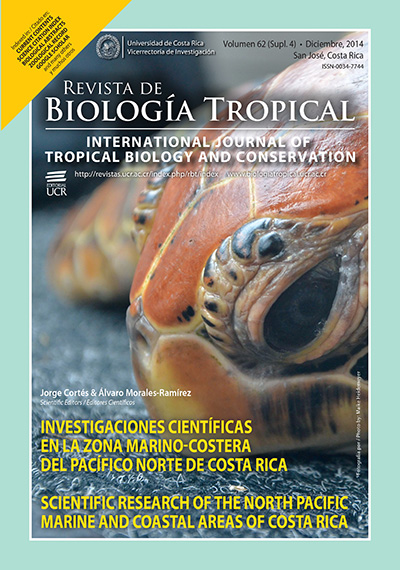Abstract
The mangroves of the North Pacific of Costa Rica are among the most altered coastal ecosystems in the country. Scientific information about their physiology, ecology, structure, and geochemistry is limited. This study analyzed the structural complexity and species composition of Potrero Grande and Santa Elena mangrove forests. Two visits were carried out to each mangrove between May and June 2012. The Point-Centered Quarter Method was used to determine forest structure. Mangrove species, height, diameter at breast height, and canopy density were noted at multiple points along transects. Associated fauna and cover of epiphytic macroalgae were recorded when present. Interstitial water salinity was determined at each point. Basal area, dominance, importance value, and density were calculated for each mangrove species and complexity index for the forests. Rhizophora racemosa had the highest relative dominance and importance value at both sites. Santa Elena had the highest complexity index (CI=26.9), this could be due to the high density found. Potrero Grande mangrove is one of the best developed mangrove forests on the Pacific coast of Costa Rica, given its structural characteristics (relatively tall trees and high tree trunk diameters) and species composition. While Pelliciera rhizophorae was known to have reached its northern limit at the Potrero Grande mangrove; this study extends its distribution further north for the Pacific coast of Costa Rica. Unlike Potrero Grande, Santa Elena is not adjacent to a marine protected area, resulting in uncontrolled extraction and tourism activities within Santa Elena Bay. The creation of a marine protected area in Santa Elena Bay is recommended to provide enhanced protection to this ecosystem. Rev. Biol. Trop. 62 (Suppl. 4): 33-41. Epub 2014 Diciembre 01.
References
Castillo-Cárdenas, M., Toro-Perea, N., & Cárdenas-Henao, H. (2005). Population Genetic Structure of Neotropical Mangrove Species on the Colombian Pacific Coast: Pelliciera rhizophorae (Pellicieraceae). Biotropica, 37, 266-273.
Cintrón, G., & Schaeffer-Novelli, Y. (1984). Methods for studying mangrove structure. In: S. C. Snedaker, & J. G. Snedaker (Eds.), The Mangrove Ecosystem: Research Methods (pp. 91-113). UNESCO. Bungay, United Kingdom: The Chauser Press.
Córdoba-Muñoz, R., Romero-Araya, J. C., & Windevoxhel-Lora, N. J. (1998). Inventario de los humedales de Costa Rica. San José, Costa Rica: UICN, MINAE, SINAC, Embajada Real de los Países Bajos.
Cortés, J., & Jiménez, C. (2003). Corals and coral reefs of the Pacific of Costa Rica: history, research and status. In: J. Cortés (Ed.), Latin American Coral Reefs (pp.361-385).Amsterdam: Elsevier Science B.V.
Ellison, A., Farnsworth, E. & Moore, G. (2010). Pelliciera rhizophorae. The IUCN Red List of Threatened Species. Retrieved from www.iucnredlist.org.
IMN (2012). Datos de la Estación Meteorológica Santa Elena (10º55’N 85º36’W) e Isla San José (10º51’N 85º54’W). San José, Costa Rica: Instituto Meteorológico Nacional.
Jiménez, J.A. (1981). The Mangrove of Costa Rica: The Physiognomic Characterization. M. Sc. Thesis, University of Miami, Miami, Florida. 130 p.
Jiménez, J. A. (1984). A hypothesis to explain the reduced distribution of the mangrove Pelliciera rhizophoraeTr. & Pl. Biotropica, 16, 304-308.
Jiménez, J.A. (1988). Floral and fruiting phenology of trees in a mangrove forest on the dry Pacific coast of Costa Rica. Brenesia, 29, 33-50.
Jiménez, J. A. (1994). Los manglares del Pacífico Centroamericano. Heredia, Costa Rica: EFUNA. 352 p.
Jiménez, J.A. (1999). Ambiente, distribución y características estructurales en los manglares del Pacífico de Centroamérica: Constrastes climáticos. In: A. Yáñez-Arancibia, & A.L. Lara-Domínguez (eds.), Ecosistemas de Manglar en América Tropical (pp. 51-70). México: Instituto de Ecología, A.C.;Costa Rica: UICN/HORMA;Silver Spring, Maryland: NOAA/NMFS.
Jiménez, J.A., & Soto, R. (1985). Patrones regionales en la estructura y composición florística de los manglares de la Costa Pacífica de Costa Rica. Revista de Biología Tropical, 33, 25-37.
Kathiresan, K., & Bingham, B. L. (2001). Biology of mangroves and mangrove ecosystems. Advances in Marine Biology, 40, 81-251.
Nellemann, C., Corcoran, E., Duarte, C. M., Valdés, L., De Young, C., Fonseca, L., Grimsditch, G. (eds). 2009. Blue Carbon: A Rapid Response Assessment. United Nations Environment Programme, GRID-Arendal. Norway: BirkelandTrykkeri AS.
Pizarro, F., & Angulo, H. (1994). Diagnóstico de los manglares de la costa Pacífica de Costa Rica. In: J.F. Angulo, & H. Suman (eds.), El ecosistema de manglar en América Latina y la Cuenca del Caribe: su manejo y conservación (pp. 34-63). Miami, Florida: University of Miami.
Pool, D. J., Snedaker, S. C., & Lugo, A. E. (1977). Structure of mangroveforests in Florida, Puerto Rico, Mexico, and Costa Rica. Biotropica, 9, 195-212.
Ramsar (1999). Ficha informativa sobre humedales Ramsar. Manglar de Potrero Grande. http://www.wetlands.org/reports/ris/6CR008en_FORMER_1999.pdf
Samper-Villarreal, J., Cortés, J., & Benavides-Varela, C. (2012).Description of the Panamá and Iguanita mangrove forest of Bahía Culebra, North Pacific coast of Costa Rica. Revista de Biología Tropical, 60 (Supplement 2), 109-120.
Silva-Benavides, A.M. (2009). Mangroves.In: I. S. Werthmann, & J. Cortés (Eds.). Marine Biodiversity of Costa Rica, Central America (pp. 123-130). Berlin: Springer + Bussiness Media.
Soto, R., & Jiménez, J. A. (1982). Análisis fisionómico estructural del manglar de Puerto Soley, La Cruz, Guanacaste, Costa Rica. Revista Biología Tropical, 30, 161-168.
Zamora-Trejos, P., & Cortés, J. (2009). Los manglares de Costa Rica: Pacífico norte. Revista Biología Tropical, 57, 473-488.
Comments

This work is licensed under a Creative Commons Attribution 4.0 International License.
Copyright (c) 2014 Revista de Biología Tropical






